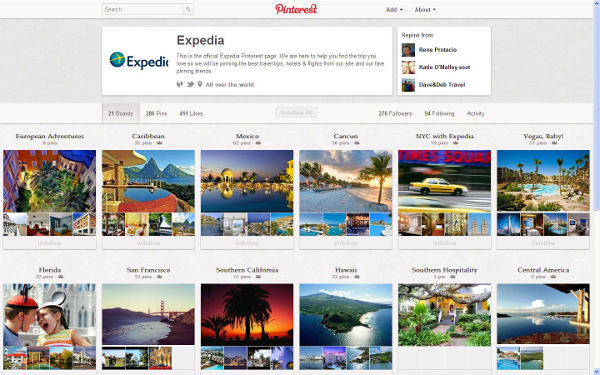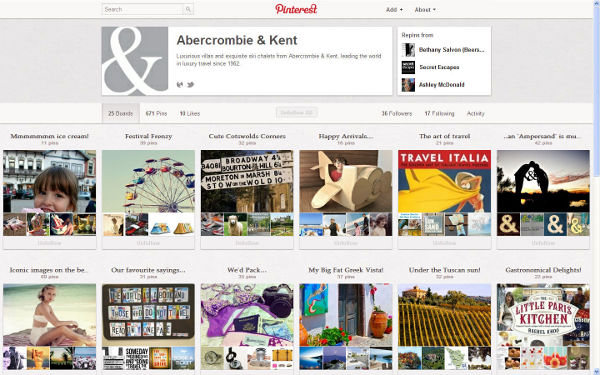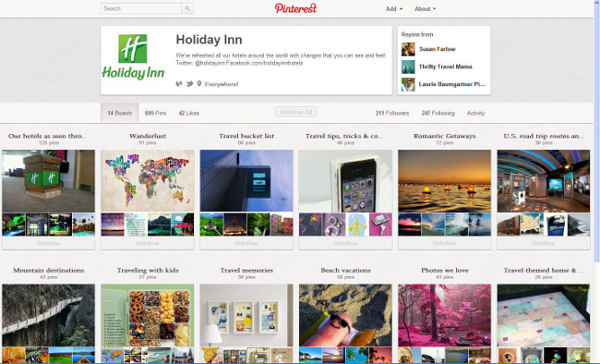Making Pinterest Work for Your Travel Brand
If you are already using Twitter and Facebook to promote your travel brand then Pinterest should be the next on the list. Though it has ‘just’ 20 million or so users it is growing faster than either Twitter or Facebook did at the same stage. Moreover, early adopters report that it is a leading source of referral traffic to their websites. Andrew Hennigan shares some secrets
Pinterest is like a Facebook with only pictures. Users can create virtual ‘boards’ where they can ‘pin’ pictures they have found on other websites or upload them from their own computer. Each picture can have a brief description where you include keywords, making it easier to find in searches. Pins are organised by a single topic like ‘Places I’d Like to Visit’, ‘Things I’d Like to Buy’ and so on. You can ‘follow’ other users’ boards and on your home page recent pins from these boards will appear. You can then browse through the pictures pinned by the people you follow and ‘repin’ pictures you like to your own boards, ‘like’ them or ‘comment’ on them. As on Twitter you can follow someone without them having to follow you.
Many travel brands have tested Pinterest boards before going mainstream. “We are currently just testing it in the UK,” says Jill Lloyd, senior PR & social media manager at Expedia, “primarily as a means to share the passion for travel that drives the people behind the Expedia brand.”

VisitSweden, an early adopter in destination marketing social media, is also experimenting with Pinterest before rolling out official programmes. “Our marketing team is encouraged to use it for personal purposes during work hours to gain the skills and experience necessary to use this very exciting tool in the near future,” says Maria Ziv, VisitSweden’s director of marketing.
Most of the pictures pinned on Pinterest come from websites, and this is why it is so valuable for firms. If you post a picture from your own website on one of your boards, when someone repins your picture it carries with it the link to your website page. Another user who wants to learn more can simply click on a picture to be taken to your website. More than 80% of pins are actually repins; this means a pin will usually be seen by many people who do not follow your page directly. They will always be able to see who the original source was and find the link to the original website. Copyright is an issue that some travel brands are addressing. VisitSweden has created a bank of images already cleared for use in social media contexts like Pinterest. “We spent a lot of time during this development looking into the legal aspects of image use and the rights of photographers,” explains Maria Ziv, “and we will use the knowledge we acquired there to ensure a responsible and respectful way of using Pinterest in the future.”
One goal is to drive referral traffic to company websites, but often the aim is more brand focused. “Our strategy is to build brand affinity and engagement,” says Brad Wilson, chief marketing officer at Travelocity adding that, “we want people who visit our boards to get inspired to dream and to share travel experiences.” Abercrombie & Kent Villa & Chalets takes a similar approach. “The aim for Abercrombie & Kent Villas’ Pinterest page is to inspire people to travel through making them inquisitive about a new place whether that’s through visual inspirational quotes or just showing some fresh Italian produce,” says Claire Allen, head of marketing at A&K Villas. “Essentially it’s a feel-good page which should capture people’s imagination and give them the same feeling they have when they are discovering new places.”
Because it is a visual medium Pinterest addresses a broader audience than Twitter or Facebook. “One of the advantages of Pinterest compared to other social platforms is that language is not essential, which offers a wider reach,” explains Expedia’s Lloyd, “and we know that in certain cultures images are more powerful than text. While Germans tend to make choices based on fact the French are more likely to be swayed by a stunning image.”
According to Allen A&K’s social media activity focuses mainly around Twitter and Pinterest at the moment. “If we are posting offers for Tuscany on Twitter it would be sensible to add a link in the tweet to our Tuscany Pinterest page to take customers directly there,” she says.
Pinterest is simple to use, fun and surprisingly addictive. Some people turn to Pinterest for ideas about things to buy or do, some use it for inspiration and some use it to promote their own products and services. Early adopters are already using Pinterest in their business, but even major brands have followers measured in thousands rather than millions. This year it is emerging as a mainstream marketing tool so this is the ideal time for brands to add it to their social marketing mix. Pinterest is most effective for travel brands with a strong visual focus and this includes most players in the travel business, where images have always been a cornerstone of communication.
So how can your travel brand make effective use of Pinterest? Here are seven essential steps for companies adopting this new tool:
1. STUDY THE PINTEREST MARKET: Before you jump in and create some Pinterest boards take a look at your own competition and some successful players from other businesses. Identify things that work and don’t work as well as common practices of the Pinterest community. Look particularly at the kinds of pictures people are repinning, liking and commenting on. Also try using Pinterest yourself and encourage your team to do the same. This will help you get a feel for the kinds of images that your audience is likely to find appealing and to see how the most active users interact with boards.
2. CHOOSE BOARD TOPICS & CURATOR: Start by creating boards that you are ready to fill; having a few active boards looks better than having 20 empty ones. Each board should stick to a single topic – people can follow boards individually – and there is a convention that they have ‘interesting’ but understandable names. Some companies, like eDreams, have boards organised mainly by destination; others, like Club Med, organise their boards by resort and some, like Abercrombie & Kent, emphasise more travel-related topics like ‘The Art of Travel’, ‘Gastronomical Delights’ and ‘World’s Best Sandcastles’. Like all social media, Pinterest works best with regular activity. Decide who will take care of this work to ensure that your followers will see a continual stream of updates without being swamped.

3. CREATE QUALITY VISUAL CONTENT: You can start by pinning the pictures that are already on your website and other social media, but for your Pinterest account you will probably need to have more than the standard images you created for brochures, websites and the media. People will only repin images that look interesting, and competition on Pinterest is very strong. For copyright reasons you probably can’t use images from stock agencies so you might need to hire photographers, illustrators and artists to make new images. Consider high-dynamic-range photographs of your resort or destination, infographics about some travel-related theme or even retro-style travel posters. Look at other boards for inspiration and talk to visual artists who understand Pinterest.
4. FOCUS ON LIFESTYLE, NOT PRODUCT. Your goal is to have people see your pins and this will only happen if people follow your boards and repin your content. One way to achieve this is to enrich your Pinterest presence with boards related to the lifestyle around the product, rather than just the product itself. Holiday Inn, for example, has boards for each hotel plus other boards like ‘Travel Tips’ and ‘Travel Bucket List’. You find these lifestyle pins by repinning from other boards you follow, from interesting blogs, magazines and other social media. These lifestyle boards can be filled entirely with repinned content from other sites so you never need to pay for the creation of new work. Just make sure you always give credit and respect copyright restrictions. Your lifestyle boards also allow you to pin content from bloggers, media, customers and other friends, building goodwill in these communities.

5. CONNECT WITH OTHER SOCIAL MEDIA, WEBSITES. Some people will see one of your pins repinned on another board and may decide to follow your boards. You can also actively build more followers by following users who show an interest in the travel field – many will follow back –and by linking your Pinterest account to Twitter and Facebook. At the same time you should make pinning easier by placing a Pinterest ‘pin it’ button on your company website. Also ensure your website allows pinning. Some websites deliberately block pinning for copyright reasons but on older websites it is sometimes an unintended consequence of the way the website works. You can also cross connect campaigns on other social media, like KLM’s #detailtuesday where images are posted on Pinterest and questions posted on Twitter; users see the Tweets then the link takes them to KLM’s Pinterest boards.
6. INVOLVE YOUR CUSTOMERS. Another way to attract more followers and generate more impact is to engage with your customers in the same way you do on Facebook and Twitter. You can organise promotions and competitions where users pin images on their own boards but all marked with a hashtag so that you can find them and repin them to one of your boards. Travelocity does this with a board dedicated to images of their Roaming Gnome character taken by customers around the world. You can even allow selected users to pin directly to your boards. This might be an interesting way to motivate very active users of your boards, highly engaged customers or leading bloggers, who can be effective guest pinners.
7. MONITOR THE RESULTS. As with all social media you need to be tracking all the basic measures – likes, comments and so on -- so that you can monitor trends in user activity and compare with competitors. There are many simple-to-use tools for doing this, such as Pinreach or Pinpuff. You should also measure the traffic that comes to your website through Pinterest, either through standard website analysis tools like Google Analytics or dedicated tools like Pinerly which add tracking codes to your pins. With all this information you will be able to give management the return on investment data they are expecting and maybe also justify a larger budget for creating outstanding visuals in the future.
Social media is always a moving target and Pinterest is no exception. Pinterest itself will change over time, adding new features for both individual users and business accounts. The way users interact is also likely to shift as the user demographics change. There could also be some changes in response to legal questions about copyright that are not completely resolved today. This means that you should plan to review your Pinterest strategy at least every six months, or any time that there is any major change in the way the site works.
Andrew Hennigan is a writer, speaker and communications consultant with an interest in how social media impacts businesses.

